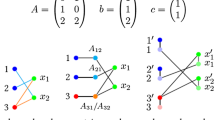Summary
Symmetries are usually not desirable in integer programming (IP) models, because they derogate the performance of state-of-the-art IP-solvers like SCIP [1]. The reason for this is twofold: Solutions that are equivalent to ones already discovered are found again and again, which makes the search space \unnecessarily large". Furthermore, the bounds obtained from the linear programming (LP) relaxations are very poor, and the LP-solution is almost meaningless for the decision steps of the IP-solving algorithm. Overall, IP-models mostly suffer much more from inherent symmetries than they benefit from the additional structure. Margot [4, 5] and Ostrowski et al. [7, 8] handle symmetries in general IPs, without knowing the model giving rise to the instance. Kaibel et al. [2, 3] took a polyhedral approach to deal with special IP-symmetries. They introduced orbitopes [3], which are the convex hull of 0=1-matrices of size p X q, lexicographically sorted with respect to the columns. For the cases with at most or exactly one 1-entry per row, they give a complete and irredundant linear description of the corresponding orbitopes. These orbitopes can be used to handle symmetries in IP-formulations in which assignment structures appear, such as graph coloring problems; see the next section for an example. All of the above approaches assume that the symmetry has been detected in advance or is known. Therefore, automatic detection of symmetries in a given IP-formulation is an important task. In this paper, we deal with the detection of orbitopal symmetries that arise in the orbitopal approach. While this problem is polynomially equivalent to the graph automorphism problem, whose complexity is an open problem, orbitopal symmetries can be found in linear time, if at least the assignment structure is given. Otherwise we show that the problem is as hard as the graph automorphism problem.
Access this chapter
Tax calculation will be finalised at checkout
Purchases are for personal use only
Preview
Unable to display preview. Download preview PDF.
Similar content being viewed by others
References
T. Achterberg. Constraint Integer Programming. PhD thesis, Technische Universität Berlin, 2007.
V. Kaibel, M. Peinhardt, and M. E. Pfetsch. Orbitopal fixing. In M. Fischetti and D. Williamson, editors, Proc. of the 12th IPCO, volume 4513 of LNCS, pages 74–88. Springer-Verlag, 2007.
V. Kaibel and M. E. Pfetsch. Packing and partitioning orbitopes. Mathematical Programming, 114(1):1–36, 2008.
F. Margot. Pruning by isomorphism in branch-and-cut. Mathematical Programming, Series A, 94:71–90, 2002.
F. Margot. Symmetric ILP: Coloring and small integers. Discrete Optimization, 4:40–62, 2007.
B. McKay. nauty User's Guide (version 2.4), 2007.
J. Ostrowski, J. Linderoth, F. Rossi, and S. Smirglio. Orbital branching. In M. Fischetti and D. Williamson, editors, Proc. of the 12th IPCO, volume 4513 of LNCS, pages 104–118. Springer-Verlag, 2007.
J. Ostrowski, J. Linderoth, F. Rossi, and S. Smirglio. Constraint orbital branching. In A. Lodi, A. Panconesi, and G. Rinaldi, editors, Proc. of the 13th IPCO, volume 5035 of LNCS, pages 225–239. Springer-Verlag, 2008.
Author information
Authors and Affiliations
Corresponding author
Editor information
Editors and Affiliations
Rights and permissions
Copyright information
© 2009 Springer-Verlag Berlin Heidelberg
About this paper
Cite this paper
Berthold, T., Pfetsch, M.E. (2009). Detecting Orbitopal Symmetries. In: Fleischmann, B., Borgwardt, KH., Klein, R., Tuma, A. (eds) Operations Research Proceedings 2008., vol 2008. Springer, Berlin, Heidelberg. https://doi.org/10.1007/978-3-642-00142-0_70
Download citation
DOI: https://doi.org/10.1007/978-3-642-00142-0_70
Published:
Publisher Name: Springer, Berlin, Heidelberg
Print ISBN: 978-3-642-00141-3
Online ISBN: 978-3-642-00142-0
eBook Packages: Mathematics and StatisticsMathematics and Statistics (R0)




